Linoleum from Forbo is naturally good.
It captures more climate-harming CO2 than it releases, if you produce it the right way, like Forbo does.
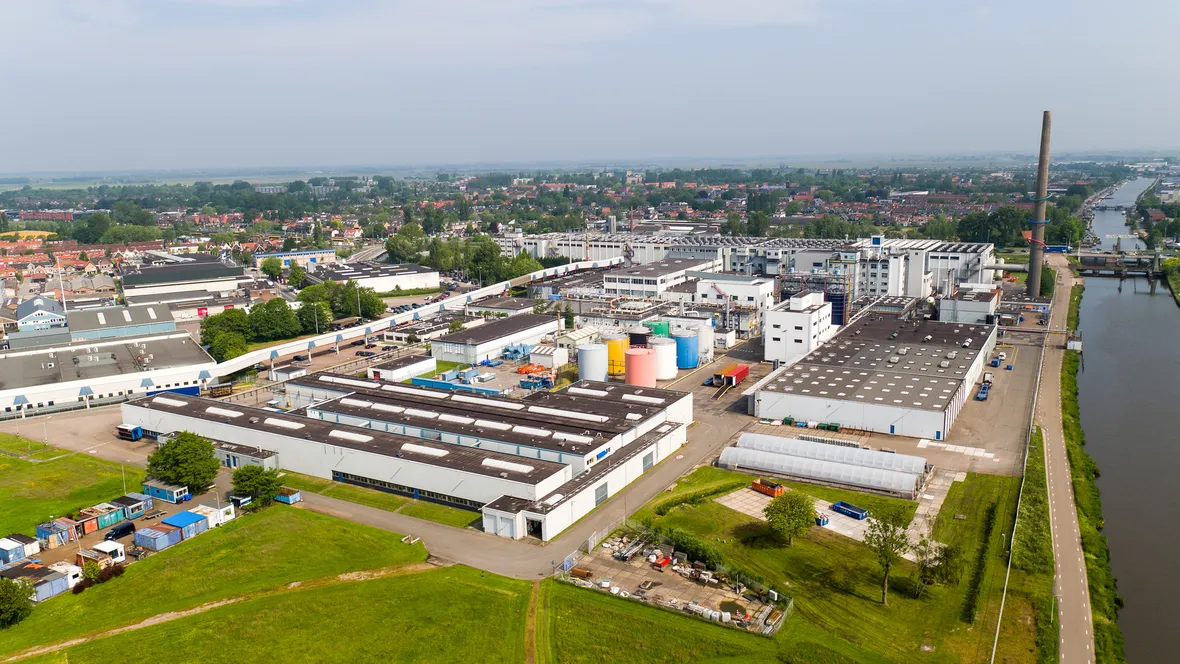
Anyone driving from Amsterdam towards Alkmaar will see mainly meadows and canals. This makes the fancy colourful rings around the plant’s dis-used chimney near the Assendelft motorway exit all the more striking. ‘It really is something of a landmark’, says Bregje Smulders. ‘Even if it was actually never used.’ The linoleum factory, the largest and most modern linoleum factory in the world, a little less than half an hour’s drive northwest of Amsterdam, is where world market leader Forbo produces hundreds of thousands of the classic linoleum floor covering every year under its Marmoleum brand. As Product Manager for linoleum at Forbo Flooring Systems, Bregje Smulders is also responsible for sustainability – she explains how the plant introduced relevant environmental changes in production so that within the product stages cradle to gate, (A1 up to and including A3), the Marmoleum product is CO2 neutral.
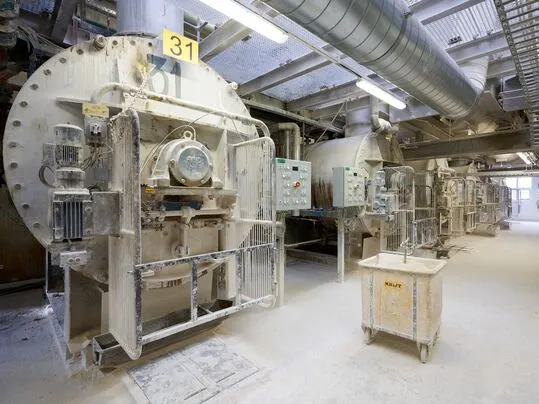
All over the world, factories release climate-harming carbon dioxide (CO2) into the air by the ton; but in Assendelft, the production of Marmoleum has been completely CO2-neutral since early 2018. ‘Actually when you calculate, we do even better than that; every square meter of Marmoleum we produce actually relieves the environment of 40 grams of carbon dioxide’, says Markus Baum, Technical Product Manager at Forbo.
‘Some of our products have even improved a bit more in the meantime’, Smulders adds. This fact is down to the company philosophy – and to linoleum itself. The origin of it all lies in the fact that 97 percent of the components of the Marmoleum floor covering are derived from natural materials, of which 62 percent is renewable, some even as annual crops. A durable, resilient floor covering that is ecological and sustainable – ‘if linoleum was to be introduced today, it would probably be the invention of the century’, Bregje Smulders points out.
Pure nature 97 percent of linoleum is composed of natural raw materials. The basis for this sustainable floor covering is linseed of which the linseed oil is extracted from the seeds of the flax plant. This linseed oil is mixed and heated-up with tree rosin to produce linoleum cement, which is in turn mixed with wood flour and finely grinded limestone and then calandered on to a 2 meter wide jute mash, which serves as a (again) natural material backing layer for the Marmoleum. A host of different colour pigments ensures great visual variety.
Factory fresh The Forbo plant in Assendelft, northwest of Amsterdam, the Netherlands, is the most modern and sustainable linoleum factory in the world. 100 percent of the electricity used for the production process comes from renewable sources like wind and solar power sources.
Today, a large share of the production stages are performed fully automatic. Today only the large black-and-white pictures on the factory walls, where electrical powered forklifts now rush past, bear witness to the handwork of the early years in Assendelft. The natural ingredients for making Marmoleum, on the other hand, have not changed much: linoleum consists of 19 percent linseed oil derived from the seeds of the flax plant, a fast-growing crop. The crop alone stores 1.6 kilograms of the greenhouse gas CO2 per square meter of linoleum. Other basic materials are jute and tree rosins, themselves plant-based raw materials, along with grinded limestone flour. Added to these ingredients are wood flour and tall oil, recycled residues from forestry and paper production. Like all other upcycling materials, technically these cannot be positively included in the environmental footprint of Marmoleum, but still have their natural character. All in all, 44 percent of the raw materials used in the linoleum production come from recycling processes.
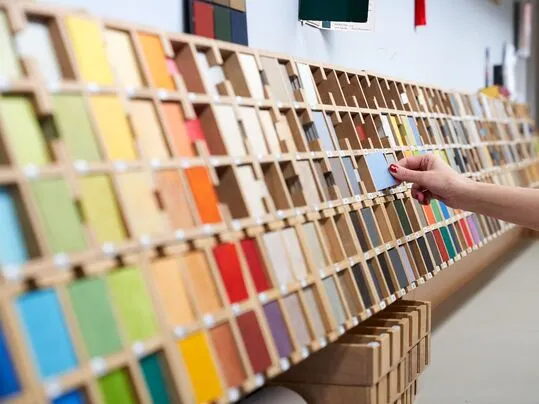
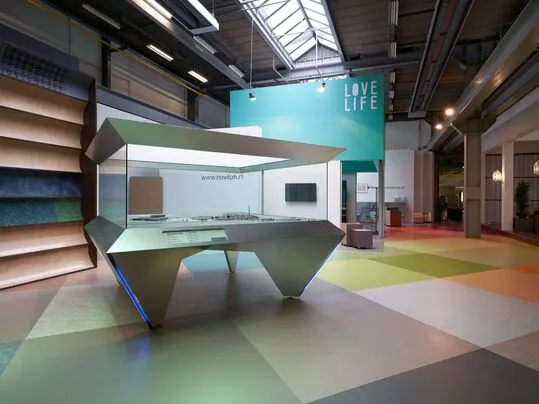
Located not far inside the factory gates are the blue silos into which lorries from Northern Germany pump in the wood flour. The linseed oil comes by ship through one of the large canals that criss-cross the meadows between Amsterdam and Alkmaar. Forbo has reduced CO2 emissions in its logistics by 31.5 percent since 2013 – without changing the transport routes. Environmentally friendly vans have been purchased, and all of the traffic on factory grounds uses electric vehicles. The path the rolls of finished linoleum take to the warehouse is emission-free, thanks to a suspension rail conveying system of 750 meters long. Suppliers play their part, too. Conventional energy sources were once used to grind the wood flour, but this is now done with wind and solar power. Forbo itself has installed solar panels on the newest of the three large warehouses for which it received a LEED gold certification. Production at the factory has now been running at 100 percent on green electricity for a decade. ‘We’ve improved a lot here’, Smulders remarks as we climb the metal steps to the building where linseed oil and tree rosin are processed to create linoleum cement. ‘It’s all a matter of taking the right decisions.’ The linoleum cement is bubbling in boilers covered with white lime – naturally, green electricity is used for the heating process here too. What then falls into the lime-covered boxes feels like warm chewing gum; some pieces are brown, others more amber in colour. Linoleum cement accounts for 30 percent of the subsequent product.
Linseed oil and tree rosin are boiled in large vessels – naturally heated with green electricity. Oxidation of the rosin and the linseed oil produces linoleum cement: a hot, rubber-like mass. To ensure that this does not become too sticky, it is powdered with limestone flour, a thin layer which is deposited [SB1] throughout the entire space. The linoleum cement is subsequently cured in high-bay warehouses.
Added to the substance are limestone and wood flour that are used as fillers, jute fibers as a substrate, colour pigments and occasionally the shells of cocoa beans to create the visual. This substance is later rolled out on webbing made of jute fibers. This process is known as ‘calendering’. The floor covering is pressed into its final form over a long production line of castors and rollers and stored into drying rooms for two weeks. And finally a UV cured surface protection is added.
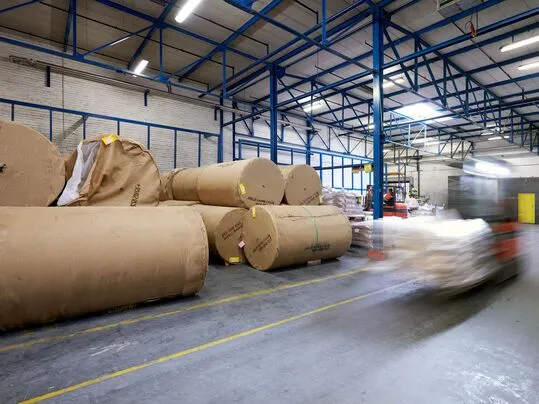
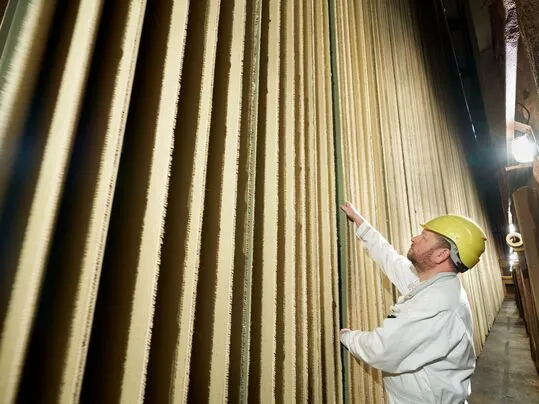
The kilometer-long sheets are now transported into the drying rooms. Experienced specialists decide when they are ready for delivery. This is a science unto itself – and the energy-intensive part of production. Because temperatures in the 20-metre-high rooms are sauna-like. Solar energy is not enough for this stage. ‘We’re still using natural gas’, Baum explains. This can still be improved, things are set to become more ecological: devices to measure energy consumption have been installed in some of the 56 drying rooms.
Stacked high
Once it is produced, the linoleum cement needs to cure. This releases a great deal of heat. Even though the warehouse is unheated, the temperature in here is usually more than 30 degrees Celsius, enough to heat other areas of the factory. Like the production halls, the special boxes for curing are dusted with lime, because the hot cement is as sticky as fresh chewing gum. It now has a brownish colour – sometimes light as caramel, sometimes darker, like chocolate. The linoleum does not receive its final colour until later on, when colour pigments are added.
High-hanging
The finished Marmoleum sheets are hung up to dry. The required heat is generated by using natural gas. Experts decide when the Marmoleum is cured – a science unto itself that calls for a great deal of sensitivity.
Highly refined
To promote even adhesion between the linoleum cement and the jute webbing, a layer of granulate that mainly consists of recycled materials is pressed in between the two. A forklift takes it to the production machine known as a ‘calander’.
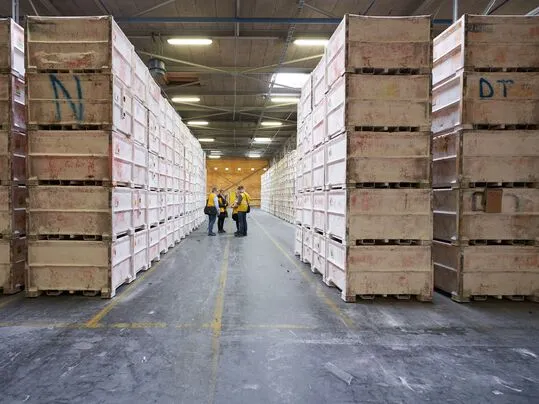
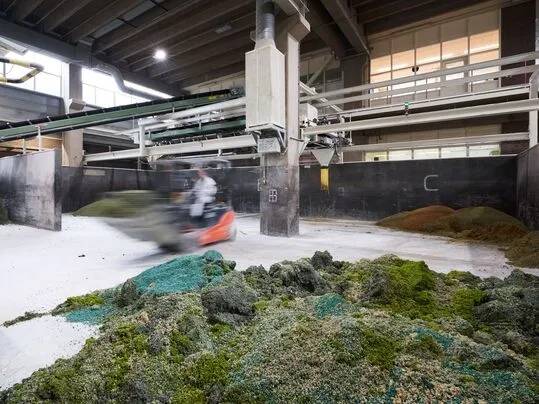
Way up high All vehicles in the factory are moved electrically. The rolls of finished linoleum are transported to the warehouse 750 meters away by means of a suspension rail conveying system – which also runs on electricity from renewable sources. The finished product thus hovers high above employees’ heads, completely ecologically, as it moves towards delivery.
‘The whole process will be improved further’, says Smulders. She is convinced: ‘We could cut future energy consumption by half.’ Once the linoleum has finally cured, it is trimmed to size and packaged before it is sent to the fully automated warehouse. The rolls await sale on yellow spindles, with a total of 110,000 rolls measuring around 60 square meters each having their place here. Some of them also come from a sister plant in Kirkcaldy, Scotland, Forbo’s second (and original) linoleum production location. ‘From here, we can deliver everything bundled for the customer in a single shipment’, says Markus Baum, adding: ‘It’s much more efficient.’
The Scottish rolls are located in the most modern of the three warehouses, the one with the solar panels on the roof. It has been awarded a ‘Leadership in Energy and Environmental Design’ (LEED) Certificate in Gold as a particularly environmentally friendly building. ‘We want to lead by example everywhere’, Bregje Smulders points out. From the hall, which looks like a big green cube, one can look up to the old chimney at the far end of the huge factory grounds. ‘We want to make a mark’, Smulders notes. The landmark to old industry nestled between the meadows and canals along motorway N8 now has company.
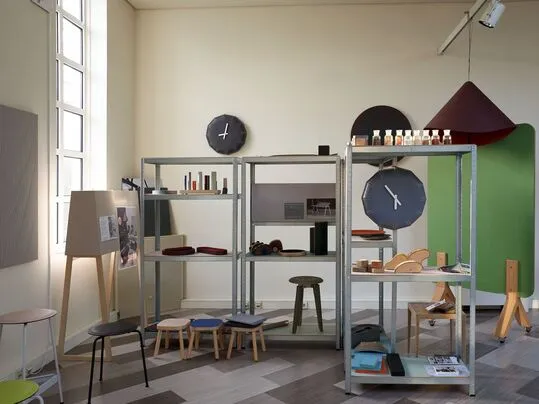
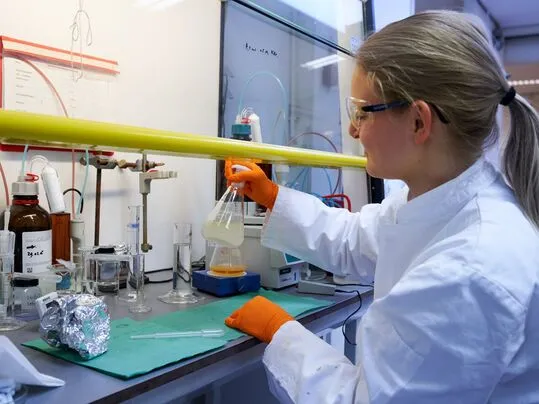
Linoleum can be used to realise not only high-quality floor coverings, but also as a service material for furniture, cabinets, doors and separation walls. There also is linoleum pin board called bulletin board which is softer en sound absorbing, often used as a classic pinboard panel or wall. The Forbo Development Department is constantly researching innovative colours, shapes and designs.
Text: Robert Otto-Moog / Photographer: Matthias Groppe, Paderborn